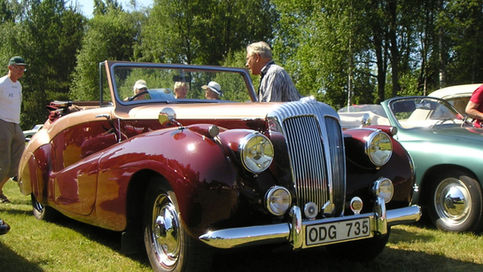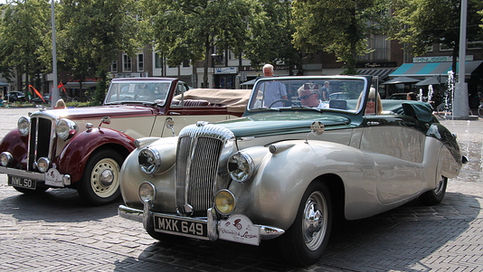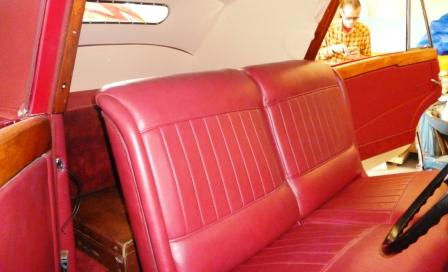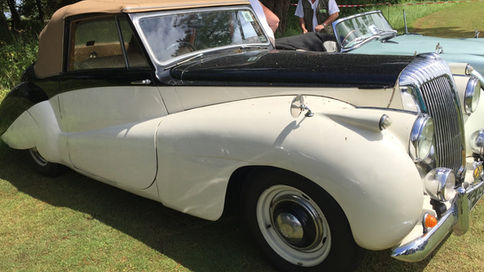Daimler Special Sports 1948 - 1952
The Daimler Special Sports drop head coupe was constructed by Daimler’s in house coach builder Barker on a modified DB18 chassis, which in turn was a development of the successful Daimler Fifteen of the 1930s. It is often reported that the car was built upon a modified Consort chassis, this is a frequently copied mistake - the Special Sports pre-dates the Consort by two years.
Chassis designation:
DB18
Number produced (maximum):
500
Chassis allocations (includes the Empress built on the same chassis):
53750 to 53999
56136 to 56188
56700 to 56774
59010 to 59239
USEFUL DATA
Number of cylinders: 6-in-line
Capacity (c.c.): 2,522
(69.6mm bore x 110.5mm stroke)
R.A.C. Rating: 18.2
Compression ratio: 7:1
Output: 85BHP @ 4200RPM
Sparking Plugs: 14mm Lodge CB14
Carburettors: Twin SU
Fuel consumption: 20-30 MPG
Maimum speed: 85 MPH
Transmission
Pre-selective Wilson gearbox mated to Daimler fluid flywheel
Gear ratios:
1st ---------- 14.57
2nd --------- 7.97
Top --------- 4.857
Overdrive -3.55
Reverse - 5.4
Final Drive:
Underslung worm. Ratio: 7/34
Capacities
Dimensions
Turning circle: Titanic 42 feet
Wheelbase: 9ft 6ins
Track: 4ft 4ins
Length overall: 15ft 6½ins
Ground clearance: 6ins
Weight: 32 CWT (3584 pounds, 1929 KG)
Price in 1950
Complete car with body: £1,645
Plus Purchase Tax of
£457 13 shillings and 11 pence
TOTAL:
£2,102 13 shillings and 11 pence
Capacities
Fluid flywheel - 9 pints (recommend Straight 30 grade)
Gearbox - 4 1/2 pints (recommend Straight 30 grade)
Rear axle - 3 pints (recommend Straight 140 grade)
Petrol tank(inc. 2 gallons reserve) - 14 gallons
Tyre Size: 6.00 x 16
Pressure front - 31 lbs/sq.in.
pressure rear - 33lbs/sq.in
Road Test dates
14th June 1950
The Motor
"A medium-sized fast touring car in the grand manner"
12th May 1950
The Autocar
" Striking example of British quality car"
History. Kevin Bennett
Prior to the Second World War Daimler, along with other firms, often used the term ‘sports’ to describe a car’s coachwork. The 1932 Lanchester Ten Sports Coupe, for example, had identical mechanical specification to the company’s 6 light family saloon, upon which chassis it was built. The post-war Special Sports, whilst by no means an out and out sports car, had several important performance-related modifications, the most notable being an overdrive gearbox, high ratio differential, alloy cylinder head and twin carburettors. The standard DB18 chassis had built-in jacks, an automatic lubrication system and heater as standard, which of course also feature on this car.

The Special Sports was certainly sporting by comparison to the saloon car it shared a chassis with, but should really be regarded as a comfortable high-speed touring car. Its seasoned ash frame, heavy upholstered seats, thick Wilton carpet and beautifully crafted wooden trim, increases the weight of the car which reduces the effectiveness of the twin carburettors and alloy cylinder head. However, the car will comfortably cruise at the legal limit, and with a maximum of 85mph is easily capable of motorway speeds - although this is not the best way to enjoy these cars, touring at 55mph on ‘A’ & ‘B’ roads suit it much better. The Special Sports is also remarkably economical, 30 mpg being achievable, an impressive figure for a car of its size and weight. The long wheelbase and excellent suspension, independent at the front, iron out the bumps and give the car a lovely long-legged ride. These Daimlers will tour all day leaving the driver and passenger feeling as fresh as the moment they sat in the car.

Road conditions and vehicle performance have altered massively in the last 60 years, but a Special Sports will still keep up with the traffic, although drivers who expect instant acceleration will probably be disappointed. Steering is heavy at parking speeds, but very comfortable to use once on the move. Properly maintained, the brakes are progressive and are more than adequate for the car's performance.
Journalists and road testers of the day loved the Special Sports, racing driver, Sir John Cobb, writing for The Field in December 1950 reported: “A break with tradition which unites quality and performance… A cruising speed of 78mph which could be maintained indefinitely”, and concluded, “for a long journey there are few cars I would rather drive.” High praise indeed from the World Land Speed Record holder.

The Special Sports engine was first seen in the 90 bhp Daimler Dolphin competition cars built in 1939. Unfortunately, production was brought to a halt by the outbreak of World War 2, however the DB18 engine was used to power the highly successful Daimler ‘Dingo’ Scout Car during the hostilities and proved highly efficient and reliable. Properly maintained these engines are capable of huge mileages. Smooth and torquey, combined with the fluid flywheel and Wilson self-changing gearbox, they provide a silky drive and suit the style of the more mature driver.
If you like to be noticed and enjoy touring, a Barker Special Sports is an excellent choice. The car has superb seating for 2 adults, and masses of luggage space (the single rear sideways facing seat is removable to allow for more luggage). As the front seats align as a bench and allow for 3 abreast, it is also capable of carrying four persons.

With the fully lined mohair hood raised, the car feels like a saloon, it is quiet and opulent. With its high-grade leather, thick Wilton carpet, woollen headlining and a beautifully sculpted dashboard the interior is simply gorgeous. Hood down, the car is still remarkably quiet and really comes into its own, you will find yourself looking for excuses to drive it. The looks, from any angle, compare with the very best coach-built cars of the pre and early post-war era. If you are a shrinking violet it may be wise to avoid buying one of these cars, you cannot drive one without pedestrians spinning on their heals to watch it pass.
Around 500 of these handsome, hand-built coupes were built in four batches and over 300 are known to exist, a remarkable survival rate. Restoration costs are high and the best advice regarding purchase is to buy the best you can afford. However, if you enjoy restoration work you will find a Barker Special Sports is an ideal candidate for home renovation, most jobs being well within the scope of the home mechanic.

Launched at the1948 London Motor Show, the Daimler was never intended to sell in high numbers, it was hand-built, exclusive and predictably expensive, costing twice as much as the Jaguar XK120 which was launched at the same show. It seems unbelievable that today one of these beautiful cars can be purchased for a fraction of the current value of the Jaguar sports car.
The body is constructed using aluminium over a well-seasoned ash frame, with steel front wings and screen surround. The doors are a composite, using steel and wood with an alloy outer skin. The interior is particularly luxurious. The leather, carpets and interior fittings are all hard-wearing, but expensive to restore, some original low mileage examples exist and they are naturally highly prized.

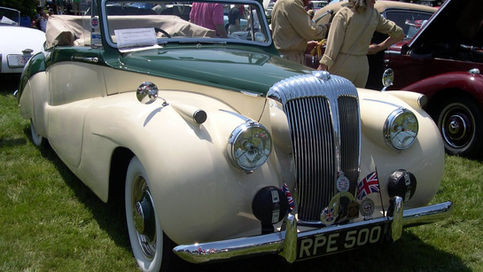
Road Test. "The Motor" 14th June 1950
Click on a page to expand
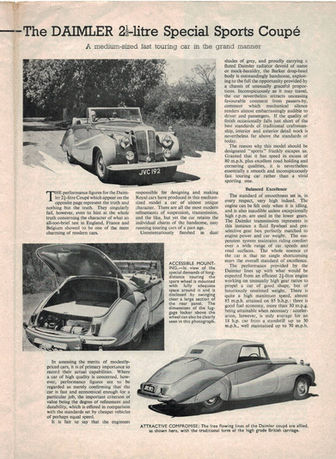
Road Test. "The Autocar" 12th May 1950
Click on a page to expand
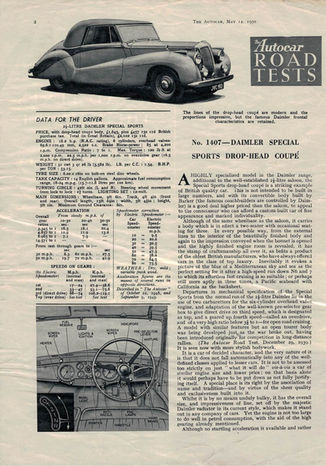
The car in the photographs was discovered in poor condition by the writer in a council lock-up garage.
JVC 192 was Daimler’s press car and appeared in many motoring and lifestyle magazines.
.jpg)
_JPG.jpg)
The red and cream car 228 DLT was purchased as a jigsaw puzzle of parts, restored over a five year period, it took longer to load and unload the hired trailer than the journey to collect it from Bristol to Birmingham and back!
_JPG.jpg)

If you would like to know more about these wonderful cars or have one that may not be recorded on the DLOC worldwide register please contact Kevin Bennett (editordloc@dsl.pipex.com) or visit www.daimlerandlanchester.com


